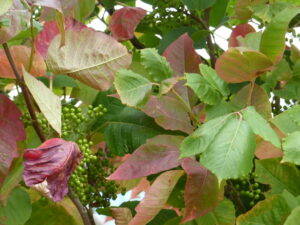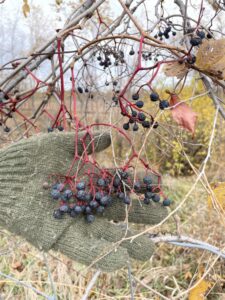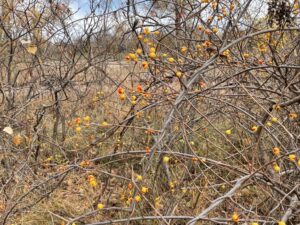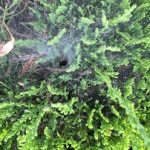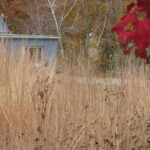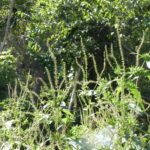We think of fall as migration time when all the birds leave. And there is a great birdcast website to see in live time the flights. But an autumn walk through a park with wild edges reveals shrubs, bushes, and grasses alive with bird activity. Visit an orchard on a cold winter day and the odds are good for spotting robins pecking on frozen dropped apples, but wild fruits are more common, all just beyond suburbia.
Let’s step back to spring. When Rich worked at the Indian Creek Nature Center his phone would often ring during those first warm days. With excitement callers would announce that the robins had returned. Spring’s here!
Seeing a robin on a spring lawn gives the illusion that they’ve just made a long journey from a faraway wintering ground down south. Robins, bluebirds, and other birds usually just shift where they live and forage as seasons change.
Ecological Survivors
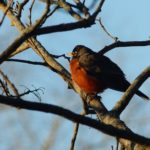
A robin surveys the area
Robins, in particular, are ecological survivors. They’re adapted to living on lawns and around people during the warm months, where they nest on porch eaves and forage for worms and bugs in mowed grass. The coming of fall’s cold marks the disappearance of robins from suburbia. They don’t go far and make an amazing dietary switcheroo to wild fruits.
Robins and bluebirds shun their summer buggy and wormy diet and shift to fruits and some seeds come winter.
On an October walk, we spotted several wild fruits – berries perhaps – that birds feast on during the cold months. the native plants are great – even the poison ivy – the exotics are problematic.
Here are some common winter weedy and seedy plants:
- Gray Dogwood. This small native dogwood often forms thickets along trails, parks, woods, and even yards and holds plenty of berries into cold months.
- Wild grapes. People rarely eat sour and seedy wild grapes, and sometimes birds also leave them alone during summer, but come winter the raison-like grapes make nutritious avian fare.
- Poke Weed. In late fall this tall purple-stemmed and fruited plant is hard to miss. Birds eat the frozen berries. Note: Poke berries are toxic to people and many mammals but not birds.
- Poison ivy. Gulp. This bane of allergic people is a beneficial wildlife plant. Deer and rabbits browse on the woody sprouts and birds feast on the berries.
- Asian Honeysuckle, Japanese Barberry, and Oriental bittersweet are “dirty bird plants.” Actually, birds love the berries and carry them far and wide to poop out the seeds. All three exotic plants are highly invasive and crowd out more desirable native plants. Birds have helped them conquer woodlands and field edges to the detriment of healthy bio-diversity.
- Poison Ivy berries are a favorite of birds.
- Wild grapes are a tasty winter treat.
- An invasive species and favorite of birds.
Winter Fare Is More Than Fruits
Winter bird fare isn’t just fruit. Many birds glean frozen spiders and insects from crevices in tree bark and dozens of species continue to eat grass and “weed” seeds. That’s a problem with mowed lawns. They produce no seeds, so few birds visit them during the colder months. Taller growing grasses, flowers, and shrubs often hold their seeds into the winter and are bird magnets.
- This beneficial spider controls insects in the yard.
- Birds bob on prairie grasses.
- Ragweed seeds last through the winter.
Want to have birds in the yard all winter? Keeping feeders stocked helps, but better results come when homeowners encourage buffers of native shrubs, vines, and grasses that produce natural winter bird food and habitat. Most people love their tidy lawn, but edging the lawn, usually along a property line, or creating “pocket prairies” with native or desirable tall grasses, wildflowers, and shrubs adds summer color and year-round wildlife appeal. So, we encourage readers to create and leave wilder spaces for the birds!

